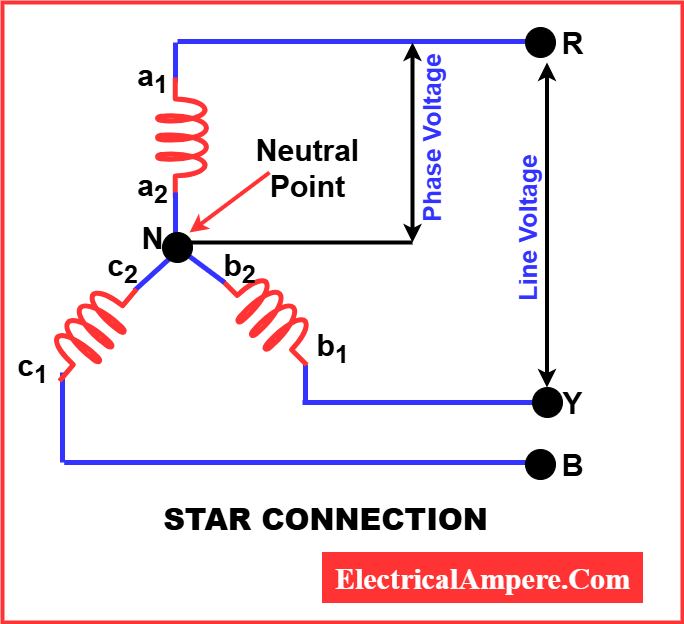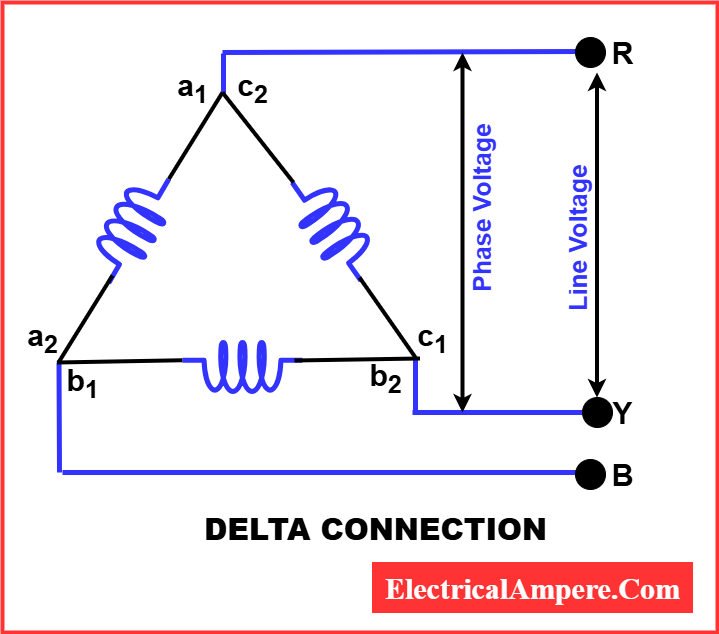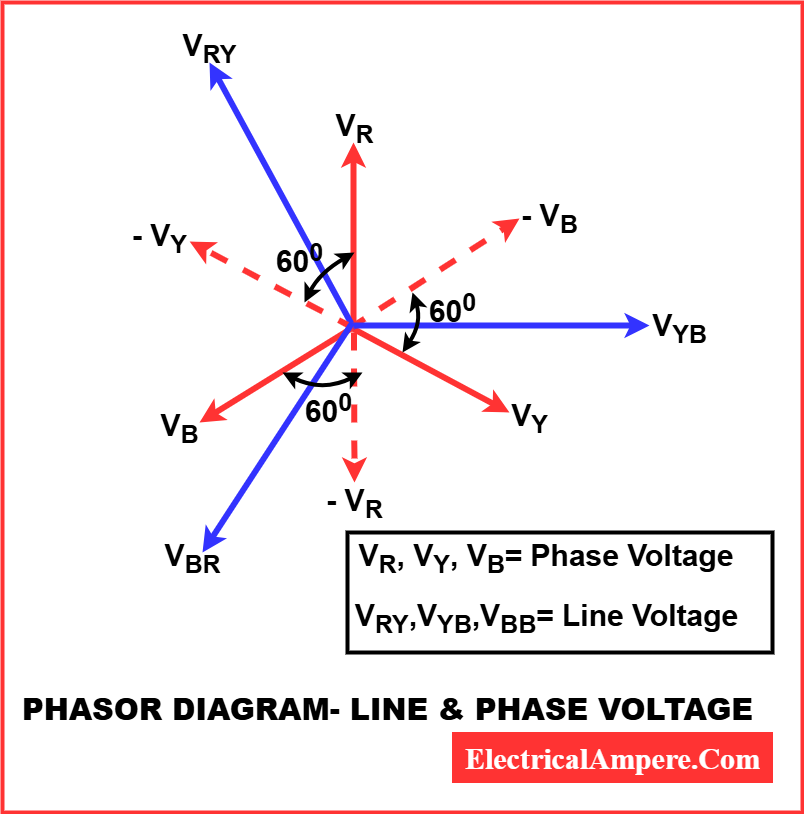Line voltage in a 3-phase system is a fundamental concept in electrical engineering, as it defines the potential difference between any two phase conductors. Understanding it is essential for safe power distribution, efficient transmission, and proper equipment operation.
In this article, we’ll break down the concept of line voltage in a 3-phase system, its relation with phase voltage, formulas, and its importance in real-world applications.
What is Line Voltage?
In a 3-phase system, three alternating currents are generated, each separated by 120° electrical phase difference.
- Phase Voltage (Vph): The voltage measured across a single phase winding and neutral.
- Line Voltage (VL): The voltage measured between any two line conductors of the system.
Simply put:
- Phase voltage = Voltage between line and neutral
- Line voltage = Voltage between any two phase conductors
Relation Between Line Voltage and Phase Voltage
The relation depends on the type of connection:
1. Star (Y) Connection
In a star connection, each winding end is connected to a common neutral point.

- Formula: VL=√3×Vph
- Example: If phase voltage is 230 V, then VL=√3×230=398 V
2. Delta (Δ) Connection
In a delta connection, windings are connected in a closed loop.

- Formula: VL=Vph
- Example: If phase voltage is 230 V, then line voltage is also 230 V.
Phasor Diagrams & Vector Representation for Line Voltage
Understanding line voltage in a 3-phase system becomes easier with phasor diagrams, which visually represent the relationship between phase voltages and line voltages.

1. Star (Y) Connection
- In a star connection, each phase voltage is represented as a vector 120° apart.
- The line voltage is the vector difference between any two phase voltages.
- This is why the line voltage (VL) = √3 × phase voltage (Vph).
- Phasor diagram helps visualize how the √3 factor arises from the vector addition of two phase voltages.
2. Delta (Δ) Connection
- In a delta connection, the phase voltage is directly across each line.
- Hence, the line voltage equals the phase voltage (VL = Vph).
- The phasor diagram shows three phase voltages forming a closed triangle.
3. Importance of Phasor Diagrams
Helps engineers and electricians visualize voltage relationships and troubleshoot problems.
Makes it easier to calculate line voltage, phase voltage, and current in balanced and unbalanced systems.
How Line Voltage is Generated in a 3-Phase System
A 3-phase system is produced by a three-phase alternator (generator). The stator of the alternator has three identical windings, placed 120° apart from each other. When the rotor turns inside the stator, it induces three sinusoidal voltages, each shifted by 120°.
- Each winding produces a phase voltage.
- When we measure the potential difference between two line conductors, we get the line-to-line voltage.
Step-by-step process:
- Generator action – A rotating magnetic field cuts the stator windings, inducing alternating voltages.
- Phase displacement – Since the coils are placed 120° apart, their voltages are also 120° apart in phase.
- Line conductors – Each phase is brought out as a separate conductor.
- Line-to-line voltage – By measuring the voltage difference between any two of these conductors, the system produces the line voltage.
In short:
- Phase voltage is generated in each coil.
- Line voltage appears naturally when two phase voltages are combined vectorially (due to 120° phase difference).
This is why in a star connection, the line voltage becomes √3 times the phase voltage, and in delta connection, it remains the same as the phase voltage.
Nomenclature of Line Voltages in a 3-Phase System
In a three-phase system, line voltages are labeled to identify each phase and maintain the correct sequence. Common notations include:
- L1, L2, L3 – European/US standard
- R, Y, B – Red, Yellow, Blue; UK standard
- U, V, W – IEC standard for motors and transformers
These labels ensure safe connections, correct phase sequence, and proper operation of motors, transformers, and other three-phase equipment.
Measurement of Line Voltage in a 3-Phase System
Measuring line voltage in a three-phase system is straightforward but requires caution, as the voltages involved are high. To measure it safely:
- Use a suitable multimeter – Ensure the multimeter is rated for high AC voltage, typically above the expected line voltage.
- Connect the probes – Place the two probes between any two of the three phase wires. This will give the line-to-line voltage reading.
- Read and record – Note the voltage displayed. This value represents the line voltage of the system.
Safety Tip: Always ensure that protective gear is worn, and the multimeter probes are rated for the system voltage. Never attempt to measure line voltage without proper precautions.
By following this method, electricians and engineers can accurately determine the line voltage for troubleshooting, system monitoring, or equipment testing.
Standard Line Voltages in 3-Phase Systems
The standard value of line voltage depends on the region:
- India & Europe: 415 V (line voltage), 230 V (phase voltage)
- USA: Common standards are 208 V, 480 V, and 600 V line voltages
- Japan: 200 V line voltage (widely used in industries)
Why Line Voltage Matters?
Line voltage plays a vital role in electrical systems:
- Efficient Power Transmission – Higher line voltage reduces current, minimizing losses.
- Equipment Compatibility – Motors, transformers, and industrial machines are rated based on line voltage.
- Safety & Reliability – Correct line voltage ensures safe operation and prevents equipment damage.
Quick Summary Table
| Parameter | Star Connection (Y) | Delta Connection (Δ) |
| Relation (VL & Vph) | VL = √3 × Vph | VL = Vph |
| Example (Vph = 230 V) | VL ≈ 400 V | VL = 230 V |
| Neutral Availability | Yes | No |
Applications of Line Voltage in a 3-Phase System
Three-phase line voltage is widely used in industries and commercial setups because it delivers higher power more efficiently than single-phase supply. Some common applications include:
- Heavy-duty motors: Industrial motors in factories and manufacturing plants rely on three-phase line voltage for smooth and efficient operation.
- HVAC systems: Large heating, ventilation, and air-conditioning units require stable three-phase power to function effectively.
- Lifts and elevators: High-capacity elevators use three-phase voltage for consistent torque and energy efficiency.
- Power distribution: Transformers and distribution networks use line voltage for transmitting electricity over long distances with minimal loss.
Using line voltage in a 3-phase system ensures energy efficiency, reduces conductor size, and provides smoother operation for heavy machinery compared to single-phase systems.
Safety Precautions When Working with Line Voltage
Line voltage in a three-phase system can be extremely dangerous and potentially lethal. Following proper safety measures is essential to prevent accidents.
- De-energize the circuit – Always switch off the main circuit breaker before starting work. In industrial settings, follow strict lockout/tagout procedures to ensure the system remains de-energized.
- Use proper personal protective equipment (PPE) – Wear insulated gloves, safety glasses, and other protective gear whenever working near live conductors.
- Maintain safe clearance – Keep a safe distance from overhead power lines and high-voltage equipment, as electricity can arc or jump unexpectedly.
- Never assume a circuit is safe –You must always treat circuits as live and check that they de-energize and ground properly before touching them
Following these precautions ensures safe handling of line voltage, protecting both personnel and equipment during maintenance or measurement tasks.
Troubleshooting and Maintenance Tips for Line Voltage in a 3-Phase System
Proper troubleshooting and maintenance ensure that a three-phase system operates efficiently and safely. Here are some practical tips:
1. Checking if Line Voltage is Normal
- Use a multimeter or digital voltmeter rated for high AC voltage.
- Measure the voltage between any two line conductors.
- Compare the measured value with the system’s rated line voltage (e.g., 415 V in India).
- Small deviations are normal, but large variations indicate a problem.
2. Identifying Voltage Imbalance
- Voltage imbalance occurs when the three line voltages differ significantly.
- Common causes: uneven loads, faulty connections, or transformer issues.
- Signs of imbalance include motors overheating, flickering lights, or unusual equipment behavior.
3. What to Do if Voltage is Unbalanced
- Inspect connections at switchboards, transformers, and distribution panels.
- Redistribute loads across the three phases to balance current.
- Check transformer tap settings and adjust if necessary.
- In persistent cases, contact a qualified electrician or maintenance engineer.
Proper troubleshooting and preventive maintenance help protect equipment, extend service life, and ensure efficient operation of three-phase systems.
Line Voltage Regulation & Power Quality in 3-Phase Systems
Line voltage stability is critical for the safe and efficient operation of electrical equipment in a three-phase system. Fluctuations or poor power quality can lead to equipment malfunction, overheating, or reduced lifespan.
1. Factors Affecting Line Voltage
- Voltage drops: Occur when current flows through long cables or overloaded circuits, reducing voltage at the load.
- Harmonics: Distort the sinusoidal waveform of voltage, often caused by nonlinear loads like inverters, computers, or LED drives.
- Voltage unbalance: Happens when the three phases carry unequal voltages, which can damage motors and sensitive equipment.
2. Effects of Unstable Line Voltage
- Overheating of motors and transformers
- Reduced efficiency of equipment
- Tripping of protective devices
- Flickering lights or electronic malfunction
3. Methods to Maintain Stable Line Voltage
- Proper load balancing: Ensure even load distribution across the three phases.
- Use voltage stabilizers or automatic voltage regulators (AVR): Helps maintain a steady output voltage.
- Regular maintenance of wiring and transformers: Prevents voltage drops and unbalances.
- Monitor harmonics and filter if needed: Harmonic filters reduce waveform distortion and protect sensitive devices.
Maintaining stable line voltage ensures reliable operation of equipment, reduces maintenance costs, and enhances overall system efficiency.
Conclusion
The line voltage in a 3-phase system is the voltage between any two lines. In star connection, it is √3 times the phase voltage, while in delta, it equals the phase voltage. Knowing the line voltage is essential for selecting electrical equipment, ensuring energy efficiency, and maintaining system safety.
Whether you are working with industrial motors, transformers, or power distribution systems, understanding line voltage will always help you design and operate systems more effectively.
Related Articles: